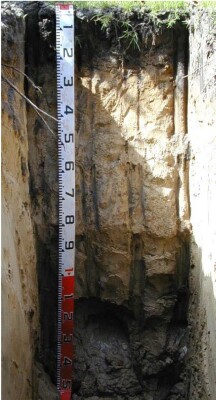HUN99 (Plot 2)
| Site: HUN99 (Plot 2) | Land Unit: Follett Dunes and Plains |
| Aust. Soil Class.: | |
 |
The majority of this land unit falls south of the Kanawinka fault. This land unit comprises areas with deep sand deposits. The residual landscape is thought to be influenced by the retreat of the Murray Sea which left stranded beach ridges oriented south west–north east. These were subsequently covered by superficial sand sheets in later depositional phases, which formed the landscape seen today. The major landforms in this land unit are dunes and swales. Podosols and Kurosols or Chromosols are the major soil types found on the dunes and rises. Podosols are soils with a ‘coffee rock’ layer (refer to photograph below). The Kurosols or Chromosols tend to have a deep sandy topsoil over the clay. The common soil types on the swales are black cracking clay (Vertosols) or Grey Sodosols. Some Ferric Kurosols or Chromosols can also occur on the swales or lower slopes of the dunes. 1.5 year old Eucalyptus globulus plantation on ex-agricultural land |
Site Description:
| Geology: Quaternary aeolian | Landform pattern: Gently undulating plain |
Soil Profile Morphology
| A1 | 0-20 cm | Very dark grey (10YR3/1) loamy fine sand; single grain structure; loose consistence when moderately moist; many medium roots; clear and smooth transition to: |  |
| A21 | 20-40 cm | Light yellowish brown (10YR6/4) with many coarse faint very pale brown(10YR8/3) mottles, fine sand; single grain structure; loose consistence when moderately moist; few fine roots; gradual and smooth transition to: | |
| A22 | 40-90 cm | White (10YR8/2) fine sand; single grain structure; loose consistence when moist; no roots observed; diffuse and smooth transition to: | |
| A23 | 90-160 cm | Light grey (10YR7/2) fine sand; single grain structure; loose consistence when wet; no roots observed. | |
| Subsoil | |||
| 160-190 cm | B horizon, light grey sandy clay. | ||
| 190-210 cm | Grey clayey sand. | ||
| 210-320 cm | Sand with sift limestone (CaCO3) fragments, with limestone becoming more concretionary (harder, denser) wth increasing depth. | ||
| Notes: Free water entering pit at 90 cm, and also at 300 cm. The density of limestone at 320 cm suggests that there may be an impeding layer to root growth at this depth, but some data from Forestry SA indicates that the presence of shallow limestone may not necessarily restrict root development. | |||
Sampled by: Ian Sargeant, Paul Feikema, Martin Clark and Kiet Quach (5 November, 2000).


